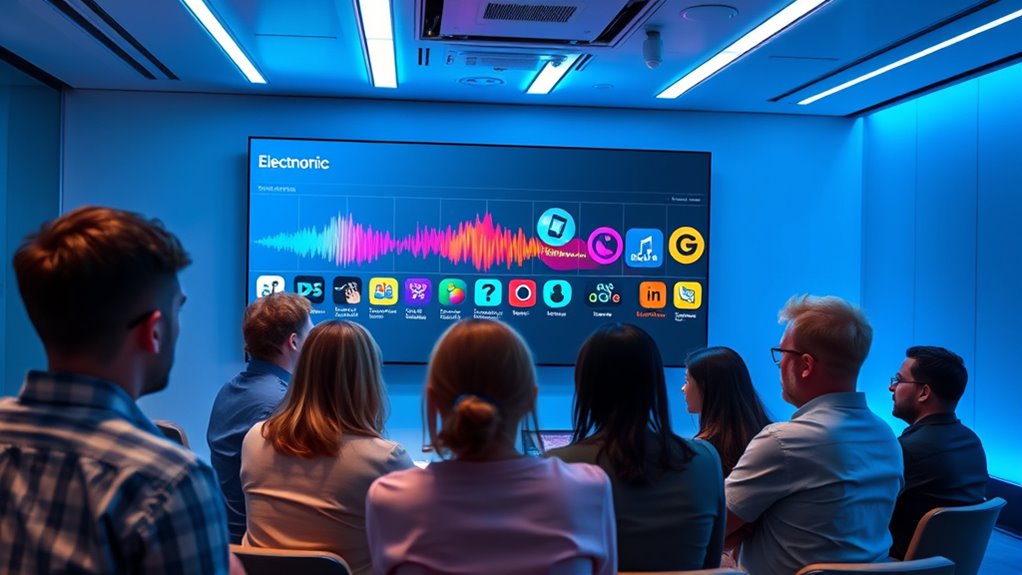Ultra curates its lineups by focusing on current musical trends, emerging genres, and technological innovations. You’ll see a mix of established acts and new artists exploring genre blends like techno with trap or indie-electronic hybrids. They respond quickly to shifts in popularity, highlighting trending styles while maintaining a foundation of electronic music roots. As genres evolve, Ultra updates its lineup to reflect these changes, offering you a glimpse into the future of EDM—continuing on will reveal more about their dynamic approach.
Key Takeaways
- Ultra reflects current musical trends by booking genres gaining popularity, such as melodic techno, future bass, and genre-blending acts.
- The festival balances emerging artists with legacy acts to showcase genre evolution and maintain audience interest.
- Lineups emphasize technologically innovative performances, including live sets and multimedia collaborations, highlighting industry advancements.
- Curators respond swiftly to genre shifts, increasing representation of trending styles to stay relevant and attract diverse fans.
- The lineup design mirrors cultural and technological progress, illustrating genre merging, innovation, and the future direction of electronic music.

Have you ever wondered how music lineups reflect changing genres and emerging trends? When Ultra curates its lineups, it’s not just about booking popular acts; it’s about capturing the pulse of the current musical landscape. As a festival-goer, you can see how the lineup evolves over the years, revealing shifts in what’s hot and what’s fading. This curation process isn’t random; it’s a deliberate effort to showcase the genres gaining momentum, while also respecting the roots of electronic music. You might notice a surge of artists blending genres—like trap-infused techno or indie-electronic hybrids—highlighting how genres are merging and expanding. By examining how Ultra selects its artists, you get a sense of the broader trends shaping electronic music and its subcultures.
Ultra’s approach to lineup curation demonstrates an awareness of audience preferences and industry shifts. When a genre suddenly becomes popular, the festival often responds quickly by booking more artists within that style. For example, if melodic techno or future bass starts trending, you’ll see those genres represented more prominently. This responsiveness keeps the festival fresh and relevant, attracting fans keen to hear what’s new. Conversely, Ultra also balances this by including legacy acts or pioneers who helped define the genre, giving the lineup depth and continuity. This mix of emerging and established artists not only reflects current trends but also educates audiences about the genre’s evolution.
Furthermore, Ultra’s lineups often mirror technological advancements and their influence on music. You might notice more artists experimenting with innovative sounds, live performances, or visual integrations, signaling a trend toward more immersive experiences. The festival’s curation thus indicates a shift from traditional DJ sets to dynamic live acts and multimedia collaborations, emphasizing how technology shapes current genres. As you follow the lineup announcements, you’ll see how these innovations influence genre boundaries, encouraging artists to push creative limits. This constant evolution guarantees the festival remains at the forefront of musical trends, making each year’s lineup a snapshot of where electronic music is headed. Additionally, the increasing hours and extended schedules of music festivals like Ultra reflect a trend towards extended hours, accommodating the diverse preferences of attendees and enhancing the overall experience.
In essence, Ultra’s lineup curation acts as a barometer for the industry’s shifting landscape. It’s about more than just booking hits; it’s a reflection of ongoing cultural conversations and technological progressions. You get a front-row seat to observe how genres coexist, merge, and evolve—offering a glimpse into the future of electronic music. As a festival attendee, you’re not just listening to music—you’re experiencing a curated journey through the latest trends, emerging sounds, and the ongoing story of genre innovation.
Frequently Asked Questions
How Do Curators Select Emerging Artists for Lineups?
You look for emerging artists that fit the festival’s vibe and resonate with your audience. You stay updated on new music through industry sources, social media, and artist collaborations. You consider their originality, live performance potential, and growth trajectory. You also balance fresh talent with established acts, ensuring diversity. By trusting your ears and instincts, you curate lineups that excite attendees and highlight the next big thing in music.
What Role Does Audience Feedback Play in Lineup Decisions?
Audience feedback is like a compass guiding your lineup choices. You pay close attention to their comments, preferences, and reactions, using this input to shape the festival experience. When the crowd loves a certain genre or artist, you’re more likely to include similar acts. This dialogue creates a dynamic relationship, ensuring the lineup resonates deeply and keeps everyone coming back for more, turning festival-goers into active participants.
How Do Genre Trends Influence Lineup Diversity?
Genre trends heavily influence your lineup decisions by shaping audience expectations and preferences. When certain genres gain popularity, you tend to include more artists from those styles to attract a broader crowd. However, you also balance this by mixing diverse genres to keep the lineup fresh and inclusive. This approach guarantees you stay current with trends while offering a variety of musical experiences, appealing to as many attendees as possible.
What Geographic Considerations Affect Artist Selection?
You’ll want to contemplate where your audience is coming from, as geographic factors shape artist choices. Think about regional popularity—locals love seeing artists they know, while international acts can draw global attention. Travel logistics and local culture also matter, influencing who’s available and fitting the vibe. By balancing these elements, you craft a lineup that feels both authentic and exciting, leaving your audience enthusiastic to see how it all unfolds.
How Do Festivals Balance Popular vs. Niche Genres?
You balance popular and niche genres by carefully mixing headliners with emerging acts to appeal to diverse audiences. You analyze current trends and audience preferences, ensuring mainstream acts draw crowds while niche genres add uniqueness. You also consider the festival’s identity and location, creating a lineup that excites loyal fans and attracts new attendees. This strategic blend keeps the festival vibrant, engaging, and memorable for all attendees.
Conclusion
You might think curating lineups is just about picking popular artists, but it’s so much more. By blending genres and staying ahead of trends, you create an experience that captivates diverse audiences. Don’t let the fear of chaos hold you back—trust in your ability to craft seamless, exciting lineups. When you embrace variety and innovation, you’ll see your festival grow into an unforgettable event that keeps attendees coming back for more.









